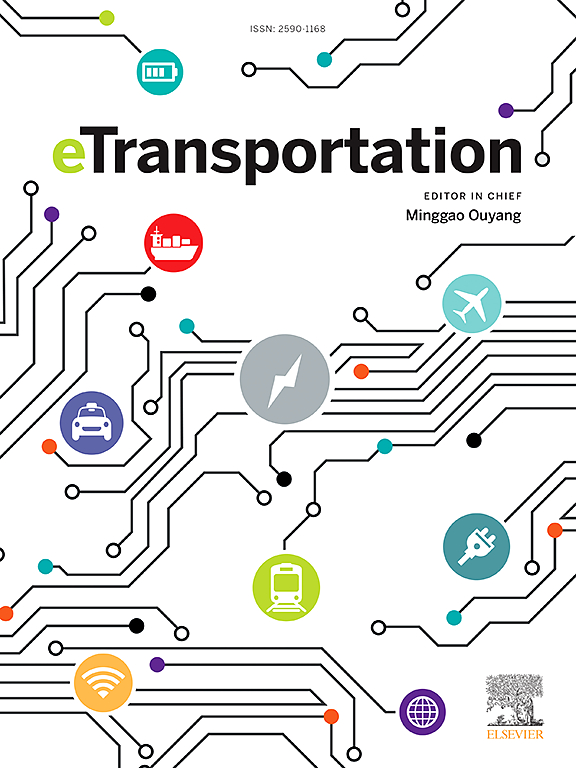氢船用PEMFC-LIB混合动力系统的电-热-气协同动力学:多尺度评估框架
IF 17
1区 工程技术
Q1 ENERGY & FUELS
引用次数: 0
摘要
随着海上运输继续主导全球贸易,质子交换膜燃料电池(PEMFC)-锂电池(LIB)混合动力船舶系统(HPSS)为减少碳排放和提高效率提供了有效的解决方案。本研究采用一维加(1D+)建模和热流方法,分析了不同工况下HPSS的电、热、气流动响应的多物理场耦合。基于相对变异性指数(RVI)的耦合响应评价体系对系统性能进行了量化。电响应分析表明,负载电流和输出功率具有较高的同步性,灵敏度强。热分析显示,在过调负载条件下,阴极催化剂层的温升为10.88 K,阴极流道显示出明显的热变化,突出了集中热管理的必要性。气体流量评价表明,曲率值增加了61.8%,反映了气体流量与负载电流之间的强相关性。耦合响应评估表明,电响应比热和气流响应更敏感。RVI值表明,热响应占主导地位,热响应最大值为1.5,电响应最大值为1.14,气流响应最大值为0.92,表明在一定条件下热效应超过电动力学和气动力学。此外,纯PEMFC运行确保了稳定的功率,热波动最小,但受负载容量的限制,联合运行促进了负载共享,但放大了热和气流变化,而LIB功率补偿有效地调节了SOC,但引入了额外的热瞬变和电瞬变。这项研究促进了海洋碳减排和效率。本文章由计算机程序翻译,如有差异,请以英文原文为准。

Electric-thermal-gas synergistic dynamics in PEMFC-LIB hybrid systems for hydrogen ships: A multi-scale evaluation framework
As maritime transportation continues to dominate global trade, Proton Exchange Membrane Fuel Cell (PEMFC)-Lithium Battery (LIB) hybrid power ship systems (HPSS) present an effective solution for reducing carbon emissions and improving efficiency. This study employs one-dimensional-plus (1D+) modeling and heat current methods to analyze the multi-physics coupling of electrical, thermal, and gas flow responses in HPSS under different operating conditions. A coupling response evaluation system based on the Relative Variability Index (RVI) quantifies system performance. Electrical response analysis reveals high synchronicity between load current and power output, indicating strong sensitivity. Thermal analysis reveals a temperature rise of 10.88 K in the cathode catalyst layer during overshoot load conditions, with the cathode flow channel showing substantial thermal variations, highlighting the need for focused thermal management. Gas flow rate evaluation indicates that curvature values increase by 61.8 %, reflecting a strong correlation between gas flow and load current. Coupled response evaluations indicate that electrical responses are more sensitive compared to thermal and gas flow responses. The RVI values show that thermal responses are dominant, with maximum values of 1.5 for thermal, 1.14 for electrical, and 0.92 for gas flow, indicating that thermal effects surpass electrical and gas dynamics in certain conditions. Moreover, pure PEMFC operation ensures stable power with minimal thermal fluctuations but is constrained by load capacity, joint operation facilitates load sharing yet amplifies thermal and gas flow variations, while LIB power compensation effectively regulates SOC but introduces additional thermal and electrical transients. This study advances maritime carbon reduction and efficiency.
求助全文
通过发布文献求助,成功后即可免费获取论文全文。
去求助
来源期刊

Etransportation
Engineering-Automotive Engineering
CiteScore
19.80
自引率
12.60%
发文量
57
审稿时长
39 days
期刊介绍:
eTransportation is a scholarly journal that aims to advance knowledge in the field of electric transportation. It focuses on all modes of transportation that utilize electricity as their primary source of energy, including electric vehicles, trains, ships, and aircraft. The journal covers all stages of research, development, and testing of new technologies, systems, and devices related to electrical transportation.
The journal welcomes the use of simulation and analysis tools at the system, transport, or device level. Its primary emphasis is on the study of the electrical and electronic aspects of transportation systems. However, it also considers research on mechanical parts or subsystems of vehicles if there is a clear interaction with electrical or electronic equipment.
Please note that this journal excludes other aspects such as sociological, political, regulatory, or environmental factors from its scope.
 求助内容:
求助内容: 应助结果提醒方式:
应助结果提醒方式:


